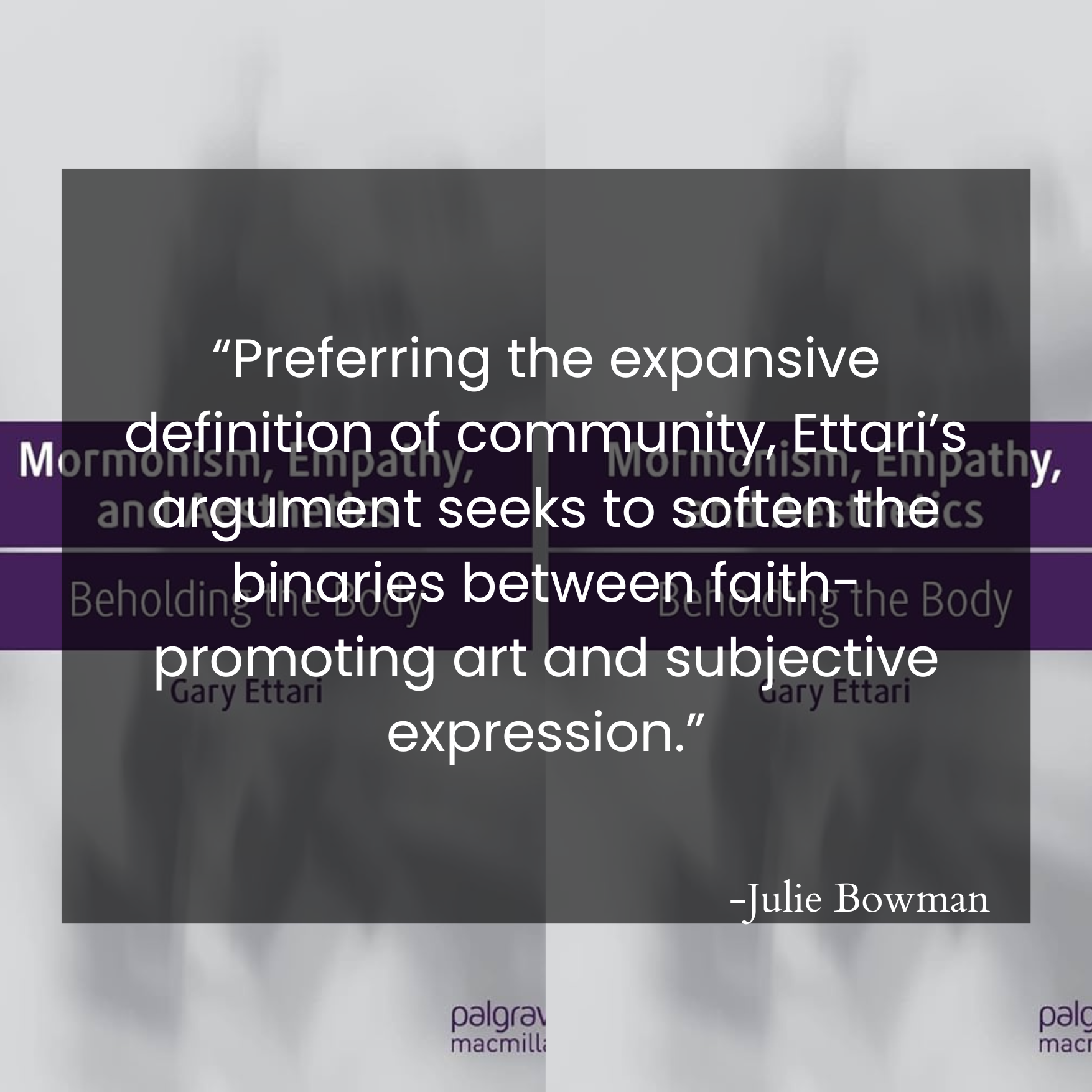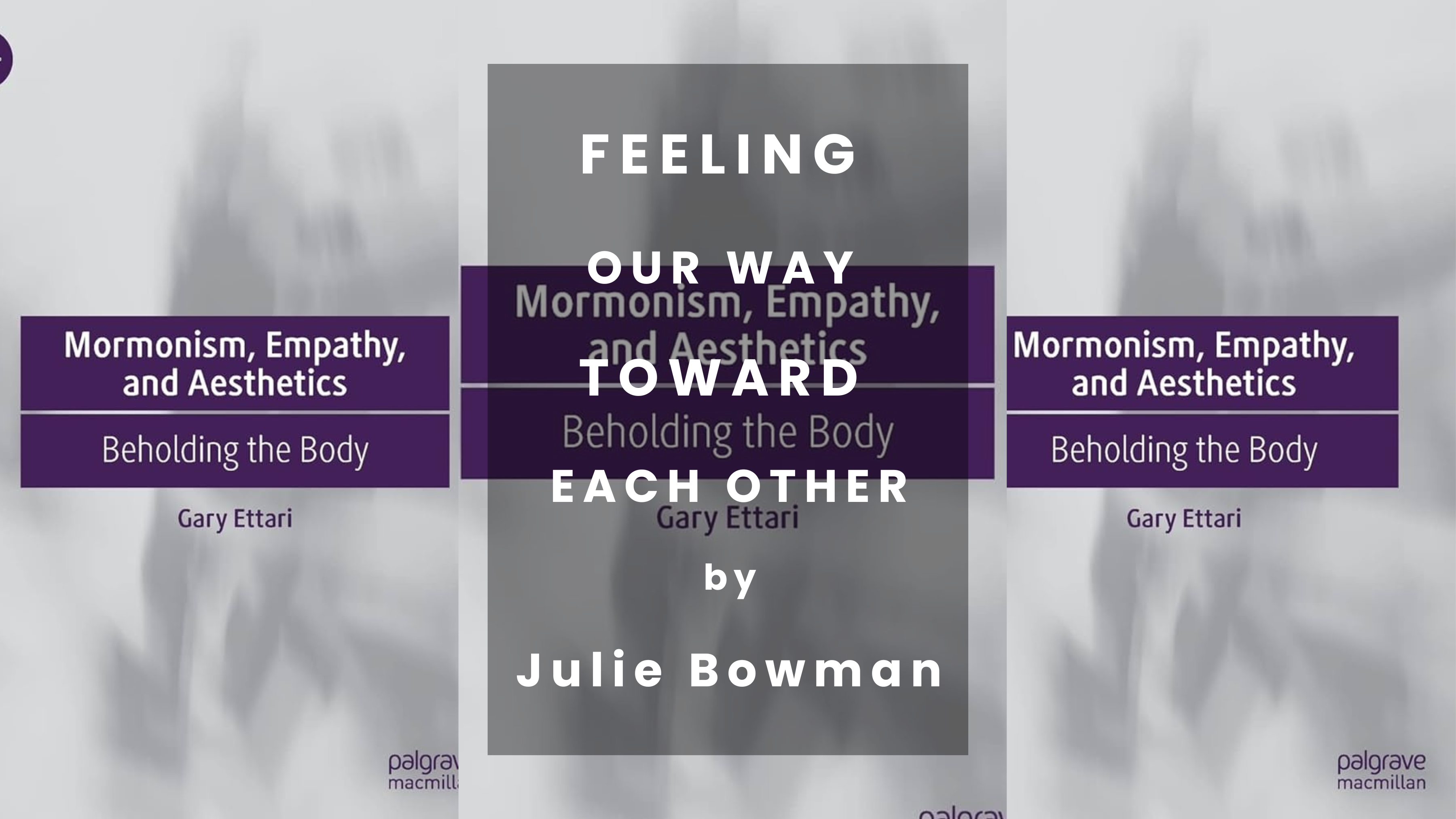Articles/Essays – Volume 57, No. 1
Feeling Our Way toward Each Other | Gary Ettari, Mormonism, Empathy, and Aesthetics: Beholding the Body
In 1997, while I was a student at Brigham Young University, the BYU Museum of Art (MOA) hosted a traveling exhibit of sculptures by Auguste Rodin, The Hands of Rodin: A Tribute to B. Gerald Cantor. The exhibit’s stop at BYU made national news when museum and university officials left four sculptures from the exhibit crated for the duration of its installation on campus. There were, as there always are, a variety of factors at play in the decision to omit the four works from the exhibit’s tenure at BYU MOA, but one factor was certainly Mormonism’s complex reverence for the human body coupled with its leaders’ long-standing assumptions about the purpose and value of art. Though this event is but a footnote (175n47) in Gary Ettari’s Mormonism, Empathy, and Aesthetics: Beholding the Body, it provides neat entry into the problem Ettari tackles: what is the significance and role of the body and art in Mormonism, and more importantly, what might it be? Grounded in the aspects of Mormon theology that emphasize universal humanity at least as much as much as a peculiar, orthodox one, Ettari proposes a more expansive, one might say sophisticated, role for the body where the body’s response to aesthetic experiences can generate empathy and help build the human community. Ettari’s argument consists of three major components: an explanation of the significance of the body in Mormon theology as a locus for confirming spiritual truth and registering emotional affects like empathy, an outline of aesthetics in Mormon theology as it corresponds to truth and morality, and an application of the theology’s expansive view of the human community to present new readings of contemporary Mormon artists.
To establish the significance of the body in Mormonism, chapter 2, “Embodied Deity and Deified Bodies,” covers a wide theological swath regarding the body, including (1) how the body guides moral and ethical action through physical sensation and emotional affect; (2) how the physicality and the emotionality of the body persists in the resurrected body as part of eternal progression toward Godhood; (3) how the embodied Mormon God possesses the same corporeal and emotive qualities; and, finally, (4) how this structure of experience, feeling, and eternal progression cultivates empathy and Christ-like compassion. Yet, Ettari notes, when applied to aesthetic experience, the feeling body’s power to be moved and to act becomes a potential danger. That is, if the body can be moved to empathy and morally good action, it can likewise be moved to undesirable emotions and immoral action via aesthetic response to morally questionable art. This danger traditionally defines Mormonism’s approach to art, one which privileges protecting body and spirit.
Having established the tension inherent in the corporeal body’s ability to respond feelingly and the need to guard the body’s purity as a divine instrument, chapter 3, “Aesthetics and Morality in Mormon Thought,” explains the narrow, didactic approach to Mormon art and aesthetics traditionally promoted by Church leaders as a consequence. Ettari outlines the specific ways in which Mormonism participates in long-standing debates about the role of art (Mormonism’s specific answer: faith-affirming instruction) and the dangers of the body as it relates to art (Mormonism’s specific answer: art which promotes bodily passion corrupts sensitivity to moral truths and righteous behavior). Ettari also depicts the fraught way Mormonism’s claims of uniqueness isolate its potential for aesthetic engagement and response. A withdrawal from the worldly creates what Ettari identifies as “purposeful exclusivity” (94), which justifies a distinct Mormon art to illustrate its unique narrative. The compelling point Ettari makes here is how this aesthetic promotes the practice of, for instance, illustrating Book of Mormon events to create a powerful visual history, without the visual information for authentic illustration (of, say, Book of Mormon people and places) or regard for literal history.
In the final chapters, through his reading of the poetry and painting of four contemporary Mormon artists, Ettari demonstrates an expansive, rather than didactic, aesthetic experience in dialogue with faith and belief. Chapter 4, “Bodies in Verse,” considers the poetry of Lance Larsen and Kimberly Johnson. Both poets, Ettari claims, position the body in their poetry as a “conduit to the divine and a means by which to universalize human experience” (135). Chapter 5, “The Painted Body,” turns to the body in visual art. Through the works of two painters, Trevor Southey and Walter Rane, Ettari illustrates an emergent Mormon aesthetic where the nude body evokes our mutual embodiment and connection via a representation of our physicality. Here, one imagines, there must be many artists and works that could be (re)considered through the lens of this empathetic aesthetic experience.
The crux of the argument that Ettari makes—the crux of most intractable arguments—resides in its warring assumptions. Is community exclusive, grounded in the practices of belief, or is community universal, grounded in our shared humanity? How might we reconcile these definitions of community when both views have theological justification? Preferring the expansive definition of community, Ettari’s argument seeks to soften the binaries between faith-promoting art and subjective expression. As these are long-standing tensions between art and religion, between particular communities and the human community, embracing a both/and expansiveness feels optimistic and humane.

If Ettari’s work has a practical weakness, it arises from the challenge of negotiating reader knowledge. On the one hand, Ettari explains Mormon doctrine and theology for the presumably non-Mormon reader, though even the raised-in-the-church reader will find the detailed and complex layering of belief about the body in Mormon theology and history a necessary and helpful foundation for the argument. On the other hand, not all individuals and academic ideas are as carefully and consistently set out as those associated with Mormon scripture and prophets. For example, “the poet and critic Susan Stewart” gets an identifier, whereas on the next page, Benjamin Lindquist, with an equally robust quotation as evidence, does not. To set out both equally would have lent a more inclusive air to the project. In the same vein, this argument’s precise focus on the body, aesthetics, and Mormon theology leaves this reader with a desire for a more expansive engagement with the way in which the collision of aesthetic experience and theological belief are not singular to Mormonism, even if the contours of the debate are unique.
Ettari’s sense that there is room for an aesthetic experience that allows empathy to generate an expansive community holds so much promise for everyone: art makers and art consumers. Such an aesthetic would abandon the binary created by a faith-affirming, didactic art that limits both the artists and the audience to instead foster the coexistence of the doctrinal truths of virtue and spiritual growth alongside the complexities of subjective human expression. It could, in fact, facilitate spiritual growth and cultivate sensitivity to truth, despite long-standing fears—by many religious groups, as Ettari notes, not just Mormons—that art corrupts the spirit and confuses truth. Ironically, this pursuit might leave behind those the community who believe in or prefer a narrower aesthetic that privileges the didacticism of the obviously faith-promoting over the truth of the messier human complexities. To leave anyone behind, would be a shame for a project like this one, though, perhaps, empathy becomes the key to bridging that divide. One hopes.
Gary Ettari. Mormonism, Empathy, and Aesthetics: Beholding the Body. New York: Palgrave Macmillan, 2022. 216 pp.


 Back to full Issue
Back to full Issue

